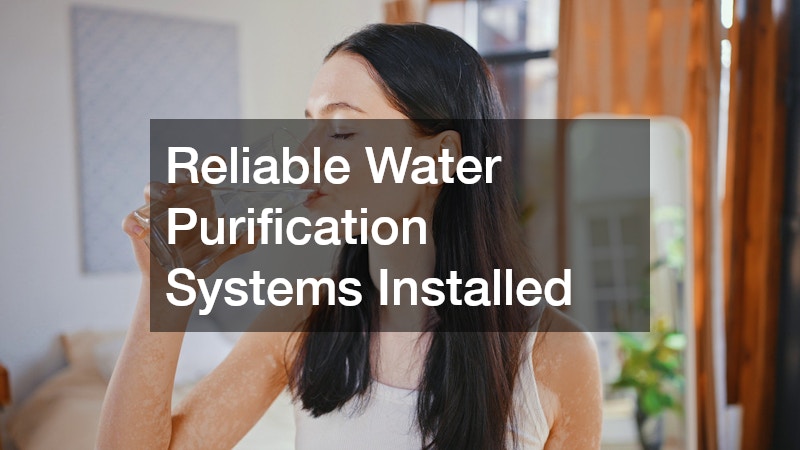Access to clean water is a fundamental human need, yet millions of people worldwide struggle daily to obtain it. The growing concern over polluted water sources has prompted communities and organizations to seek reliable solutions. Water purification plays a crucial role in addressing this global issue by removing contaminants and ensuring safe drinking water. As the demand for purified water rises, the installation of purification systems is becoming increasingly vital.
Water purification systems come in various forms and are tailored to different environments, from urban centers to remote villages. These systems are designed to eliminate bacteria, viruses, chemicals, and other pollutants that pose health risks. Through innovative technology, water purification ensures that every drop consumed is free from harmful substances. Understanding the significance of installing these systems helps emphasize their impact on public health and sustainable living.
With technological advancements and global awareness, purification has become more accessible and efficient. Governments and NGOs are investing heavily in providing resources and support to install these systems in affected areas. This effort not only improves health standards but also fosters economic growth by reducing the medical costs associated with waterborne diseases. Highlighting successful examples of purification installations can inspire other regions to take similar actions.
The Importance of Water Purification Systems
Water purification is indispensable in ensuring the availability of safe drinking water. Contaminated water sources can lead to severe health issues, including gastrointestinal infections, neurological disorders, and other chronic illnesses. Installing reliable water purification systems helps mitigate these risks by effectively removing harmful agents. The importance of such systems goes beyond health, impacting social and economic aspects as well.
By providing clean water, communities can focus on development and education rather than survival. Children who often fall sick from contaminated water are more likely to attend school regularly if they have access to purified water. Water purification systems thus contribute significantly to breaking the cycle of poverty by enabling better educational and economic opportunities. Improving access to safe water enhances the overall quality of life and longevity.
On a macroeconomic scale, reliable purification systems reduce healthcare costs by preventing diseases. Governments can allocate resources more efficiently when fewer funds are necessary for treating water-related illnesses. Additionally, purified water supports agriculture and industrial sectors by providing contamination-free resources essential for production. These systems are thus pivotal not only for human welfare but also for sustainable economic growth.
Challenges and Solutions in Implementing Water Purification Systems
While the need for water purification systems is clear, challenges in implementation persist. One significant hurdle is the financial investment required for installation and maintenance. Many regions, particularly in developing countries, struggle with the funding necessary to install these critical systems. Innovative financing models and partnerships with international organizations are essential to overcome these financial barriers.
Technological limitations also pose challenges, especially in remote and rural areas. Creating systems that are both effective and adaptable to local conditions requires ongoing research and development. Collaborating with local stakeholders helps tailor purification technologies to meet specific community needs. Emphasizing sustainability ensures that systems remain functional and efficient over the long term.
Education and awareness are crucial for the success of purification projects. Communities must understand the importance of maintaining and using these systems correctly. Training programs and outreach initiatives can empower locals to manage their purification systems effectively. Promoting a culture of water conservation and purity supports the long-term effectiveness of these installations.
Successful Case Studies of Water Purification Installations
Around the world, various successful case studies highlight the positive impact of water purification systems. In regions such as Sub-Saharan Africa, numerous villages have transformed their water quality through community-driven purification projects. One notable example is a partnership between local governments and NGOs that resulted in the installation of solar-powered purification units. These units provide clean drinking water to thousands of people, demonstrating the feasibility and benefits of collaborative efforts.
In India, initiatives focused on providing rural areas with purification systems have markedly improved public health. By utilizing advanced filtration technology, these systems drastically reduce the incidence of waterborne diseases. The involvement of local communities in the planning and implementation stages has been a key factor in their success. These projects have significantly bolstered local economies by encouraging entrepreneurship and job creation.
Another success story comes from South America, where extensive purification networks have been established in urban slums. Through public-private partnerships, these networks have expanded access to safe water for millions. This approach proves that strategic collaboration can overcome financial and logistical challenges. The sustainability and scalability of such projects set a precedent for future purification efforts worldwide.
Reliable water purification systems are indispensable in ensuring access to clean and safe drinking water. By addressing the challenges of contaminated water sources, these systems significantly improve public health and quality of life. The installation and maintenance of purification technology are paramount for communities striving for sustainable development.
Despite the financial and logistical challenges, the benefits of purification systems are undeniable. Through innovative solutions, partnerships, and community engagement, these systems can be successfully implemented even in the most resource-constrained environments. The global experience in purification provides valuable insights and strategies for overcoming common barriers.
As awareness grows and technology advances, the future of purification looks promising. Emphasizing the importance of these systems ensures safer, healthier, and more prosperous communities worldwide. Continued efforts and investments are necessary to extend the reach and efficiency of purification systems, ensuring that everyone, everywhere, has access to clean water.

